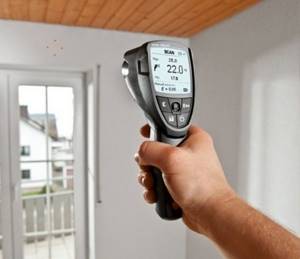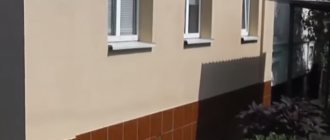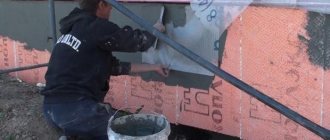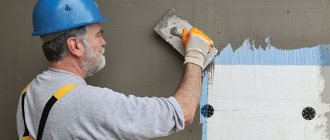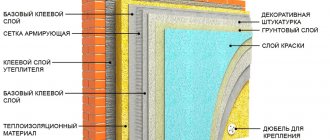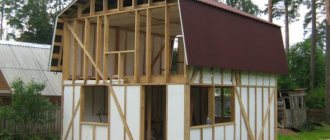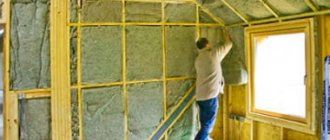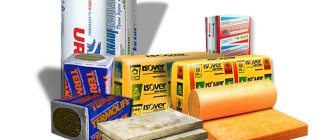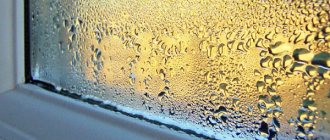Such visually unnoticeable problems, which should be paid great attention to in apartments of multi-storey buildings, include freezing of walls. Usually people face this problem when cold weather arrives.
Causes
Freezing of walls is not uncommon; this disrupts the microclimate in the house and even the well-being of people. The causes of the problem may be:
- poor sealing of seams;
- lack of insulation;
- the presence of through voids inside the masonry;
- lack of solution.
Failure to comply with technical standards or the usual negligence of builders leads to the fact that the wall cannot fully perform its functions.
Due to the reasons listed above, “cold bridges” appear, due to which the cold penetrates deep into the wall, which manifests itself in condensation. This process is explained by a shift in the dew point, which ideally should be outside.
When the structure of the brickwork is damaged, the point of contact between warm and cold air shifts, which is the cause of condensation inside the room.
Regular wetting of the surface and warm air provokes the formation of mold .
In winter, when the air temperature is significantly reduced, the condensation freezes, turning into ice fungus. This situation requires immediate identification of the causes and their elimination.
When is a thick wall good?
Thick stone walls are good for Mediterranean and tropical climates: there is no danger of freezing, seasonal and daily temperature fluctuations are smoothed out, and in hot weather you can do without air conditioning.
Thick walls are risky and expensive. But well-insulated thin masonry of half or a quarter of a brick is another, completely unjustified extreme. The fact is that a moderately massive stone wall, protected from heat loss, is capable of accumulating thermal energy and gradually releasing it into the space of the room. Warm, dry, brick walls are an excellent source of soft home warmth. They, like a sponge, absorb the energy of water heating systems or infrared emitters, and themselves become secondary sources of infrared energy. Comfortable conditions in such a room are quickly restored even after intensive cross-ventilation; You can place both a bed and a work desk next to thick, well-insulated walls - their surface will not “cool”.
Solutions to the problem
Fixing the problem is not always easy. The main freezing areas are the corners of the building. They are the ones that are susceptible to various deformations and contain voids that appear due to the adjoining walls.
If you insulate a wall from the inside, it is unlikely that this will bring a positive result. This will only move the dew point, and condensation will collect in another place.
ATTENTION! People encounter this problem mainly during the cold season, but it needs to be solved during the warm season, when it is possible to dry the house.
The best option would be:
- thermal insulation of the facade;
- seam sealing;
- thermal insulation of the foundation.
It will be impossible to thermally insulate a façade if it is lined with decorative or facing bricks. In such a situation, it is advisable to carry out internal insulation work. The effectiveness of this method is lower, but if you do everything correctly, you can get rid of the problem.
Insulation
The following work is being carried out:
- remove wallpaper and plaster;
- unstitch the seams;
- using antifungal agents, treat seams and walls;
- dry the room;
- fill the seams or cracks again with mounting film, you can use “warm” types of plaster;
- the treated surface is prepared for plastering work;
- Next comes the actual application of plaster;
- It is allowed to apply liquid insulation, which acts as an antifungal and anti-corrosion agent. The composition resembles paint and is applied using a roller or brush.
Facade insulation
Thermal insulation work is carried out to protect the façade of the building. This can be done provided that the house has not been clad, and the owner is ready for external changes to the house.
Before starting work, inspect the seams and dressings of the brickwork for consistency. If defects are found, they are embroidered and filled with heat-insulating plaster.
One of the effective methods is the installation of a ventilated facade, which is used in almost all latitudes; difficulties arise only in severe winter conditions. However, in this case it shows high efficiency.
ATTENTION! Various thermal panels, including polystyrene ones, whose price is low, have excellent performance and thermal insulation properties.
If facade work has not yet been carried out, and the house is just getting ready for finishing, even if there are no problems with freezing yet and the wall of a brick house does not get wet, it is still worth resorting to thermal insulation work. This is necessary in order to avoid similar problems in the future.
Non-standard solutions
Sometimes an architectural method is used to prevent the appearance of so-called geometric “cold bridges” - the construction of beveled or rounded corners of a building. However, this method is not applicable in all cases. But it is quite possible to build pilasters or other decorative elements on the facade.
When a corner in an apartment building gets wet, when installing a multi-level ceiling, they make a box or niche where the wiring is mounted. Constantly working, the heating device warms up the air, shifting the dew point from the room deep into the wall or towards the façade.
The structure can also be arranged vertically.
Which insulation to choose
An example of external wall insulation technology
As soon as the defects of the brick wall are eliminated, you should begin its external decoration. It will serve as insulation and a solution to the problem of freezing corners for many years. The same applies to panel houses. They are also insulated, no matter what floor the apartment is on, although here the choice of materials is limited.
Not every siding is suitable for a panel or multi-story building, since the finishing material must fit into the architecture of the house and not disturb it. The entire list of insulation materials is given in the table.
Table 2. Types of insulation for exterior decoration of a house:
| Name | Description |
| Thermal insulation plaster | Most often used for exterior decoration. It has a high vapor permeability rate, so condensation will not form inside the home. Contains particles of polystyrene foam, not sand. |
| Liquid thermal insulation | Acrylic-based compositions, whose properties are identical to mineral wool insulation. Apply in 1 or 2 layers. Such liquid insulation may also contain antifungal components. Thanks to them, mold will not form in the corners. The composition is quickly applied. Adheses well to almost any surface. |
| Thermal panels | This includes siding and sandwich panels. The latter are finished in the form of decorative bricks, imitation of the texture of natural stone and other options. Thermal panels are applied directly to the external wall. Sometimes a frame of profiles is pre-assembled. The material is easy to cut and quickly attached to the surface. No additional preparation required. |
| Mineral wool | A classic insulation method that is gradually becoming a thing of the past. There are a lot of ways to do this type of finishing. For example, first the mineral wool itself is laid along the wall, then corrugated board or siding is attached on top. |
The usual polystyrene foam is also used, on top of which a layer of plaster is applied. This is a cheap method of insulation, used not only in brick, but also in panel houses. In the latter, it is used much more often, since it allows not to disturb the overall appearance of the house. Different thicknesses of foam are used, which determine the degree of insulation. When performing work, it is important to eliminate gaps between joints. Otherwise, cold air will pass through them.
Cracks in the building
Residents of brick houses often encounter problems such as cracks, which can be vertical, oblique, horizontal, etc. Depending on the type of crack, actions to eliminate their further occurrence are determined. The cracks are being treated, because without this, further destruction of the house will continue.
Reasons for the formation of cracks in a brick house:
- natural process - shrinkage of the house (occurs after 1-2 years);
- floor load;
- deformation of load-bearing beams;
- foundation deformation and other factors.
Vertical cracks are more likely to occur due to foundation problems. More often this is a shallow depth for the structure or the impact of moving soils.
Sometimes vertical cracks can be seen in the masonry itself, where the joining of two buildings occurs. This happens when there is no expansion joint, which is simply necessary to avoid the consequences of shrinkage of two buildings occurring at different rates.
The reason for the appearance of oblique cracks is soil subsidence. Horizontal ones are formed due to incorrect bricklaying technology, as well as the quality of the rows. This manifests itself in the form of a bend in the door, window and beam. The situation may reach the point of extrusion of one of the ceilings.
IMPORTANT! The appearance of arcuate horizontal cracks is often associated with the large weight of the floor.
Cracks also appear for other reasons, such as when there is no ebb for rain and water hits the wall. The danger appears especially in winter or during the thaw period.
Determining the source
In new buildings, the problem of wall freezing is rare. The reason may be one of the following factors. But ancient houses made of panels can freeze due to at least two reasons. So, what to do if the wall freezes?
The reason is ventilation
First, it is important to check the functionality and quality of ventilation in the rooms. The channels must be clean and free of foreign objects. If the ventilation system is not functioning at all, then none of the fixes will help achieve the best result.
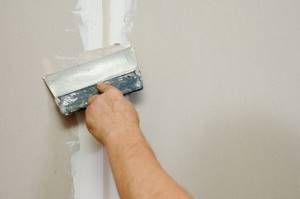
You can simply ventilate the room more often or forcefully remove moisture from the rooms by opening all windows and doors. If improvements are observed, then the problem is in the ventilation; repairing it will help cope with freezing walls.
The reason is insufficient insulation
The first signal of insufficient heating in winter is the formation of condensation on the walls. If you neglect the problem, the surface will begin to become moldy. But how does this moisture appear? From physics, you can recall the concept called “dew point”. It represents the point in the wall where moisture or steam begins to turn into water. The colder the room, the closer the dew point becomes. Moisture begins to form on the wall inside. If such freezing of the walls is observed, then the only solution is to insulate them from the outside.
If you perform insulation from the inside, this will not solve the problem, but will only eliminate the visible signs. However, behind the insulation, the wall will begin to get even more wet, and mold will begin to spread.
Poor sealing
What happens when a wall in an apartment freezes due to poor sealing? How to determine this? It is necessary to check all openings for drafts and cracks: balcony, doors, windows. To do this, it is enough to use your hand (she will feel a slight whiff, if there is one) or matches/lighter, then the flame will burn unevenly, and “dance” or go out altogether. The disadvantage of this method is that for a full check you will need to remove old finishing material (wallpaper, paint, tiles) from the corners. However, if the corners in a brick house freeze, then it will still not be possible to save the old wallpaper.
What to do when you find a source of cold? It needs to be eliminated. For example, small cracks are filled with silicone sealant. Large ones are best covered with plaster. However, in order to get rid of frozen corners and restore the microclimate once and for all, it is better to insulate the room from the outside. In this case, you can only do this with a problematic wall (at corners or at panel joints).
There is an opinion that the best option for sealing cracks and seams is polyurethane foam. Yes, it is good for dry rooms. But at high humidity, its use is not rational. It will begin to absorb moisture from the street and transfer it indoors. This is a kind of cold bridge. As a result, the problem will not go away.
The walls freeze due to the seams in a panel house, what should I do? The seams are made taking into account minor deformations. Therefore, hiding them with ordinary putty is not enough. Because it will crack again at the slightest movement. In this case, a composition is selected that is not afraid of deformation.
What to do
Before choosing a crack repair method, it is advisable to conduct a test to determine the condition of the structure and find out whether the process continues or not.
To do this, take a paper tape, indicate the date of its installation, and then monitor the process for several months.
If the tapes remain intact, then the process has stopped. If the tape breaks, it is first important to find out the reason in order to understand how to proceed.
If the crack does not grow, it is sealed with heat-insulating material and then plastered. When the facade is lined, it is impossible to do without partially relaying the bricks.
Having studied all the factors that cause the crack to expand, choose the following method to solve the problem:
- to fasten the masonry walls, metal conductors are used;
- partially relay the wall;
- lengthen the current wall or strengthen the internal ones, which will create additional strength and immobility of the building;
- carry out work to strengthen the foundation. The most difficult method, requiring the help of not only a specialist, but also special equipment.
Walls and corners in a brick house freeze due to disruptions in construction or incorrect design. It is best to resort to an external method of eliminating this drawback, but additional internal heat and waterproofing will be cheaper.
How to eliminate the inconvenience
Before embarking on comprehensive prevention of consequences, you should find the place of freezing and determine the causes. To do this, carefully examine the wall and try to determine what caused the frost to appear.
When the cause has been discovered, the elimination of the resulting defects should begin. For this procedure you will need a wall leveling compound, a spatula, a brush, coarse sandpaper and an acrylic primer.
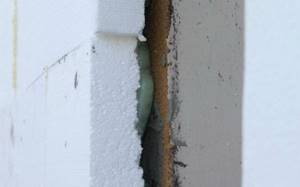
Grouting should be done as follows:
- remove wallpaper, tiles or paint from the wall;
- treat all existing cracks and breaks with putty or other mixture to level the walls;
- after drying, level the wall with sandpaper;
- apply primer.
It is recommended to repeat the entire process several times, increasing the thickness of the grout layer. You should not use polyurethane foam to fill cracks, since it absorbs moisture well from the street, allowing excess water to enter the room.
However, the method described above is only eliminating the consequences, but not the causes of freezing. To get rid of the root of the problem forever, you will need high-quality external wall insulation.
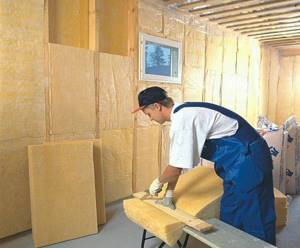
Insulation of problem areas
It is better to insulate walls from the outside, since internal insulation has a number of disadvantages. Firstly, thermal insulation from the inside, due to the thickness of the materials used, can greatly reduce the size of the usable area, which is especially important for residents of panel houses. Secondly, failure to comply with insulation technology is fraught with even worse humidity in the apartment. And thirdly, with the help of internal thermal insulation you still cannot avoid the need to change the ventilation and heating systems.
However, internal insulation also has a number of advantages. First of all, you will not have to obtain permission to change the facade from the management company. In addition, you can insulate the apartment from the inside on your own.
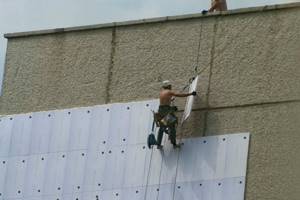
Panel buildings can be insulated using warm plaster or liquid materials. However, these modern materials have not yet been sufficiently studied. Moreover, such remedies will not solve the problem of loose interpanel seams and cracks.
It is recommended to insulate the house from the facade. If you live above the first floor, you will have to contact a construction company, which will take over the entire process.
Due to insulation, the thickness of the walls will increase, which will increase the temperature in the living room. In addition, by capturing 30–40 cm of the neighbor’s wall, you will completely solve the problem of ventilated interpanel joints.
Non-standard solutions

In addition to insulation, you can change the design of the corners in the room. Corners that are rounded or smoothed with plaster will freeze less. Also, builders recommend installing plasterboard structures in the corners of apartments with lighting fixtures mounted in them. As a result of the thermal effect from the light bulb, the temperature inside the structure will increase and the humidity will decrease. You can make pilasters outside the building in private houses. In wooden buildings, you can line the joints between logs with thermal insulation material.
To completely eliminate wall freezing, a whole range of measures are required, which should be taken immediately after the first signs of a problem appear.
How a pyrometer can help
The materials and structures of a building are affected by heat transfer forces. During the cold season, we have two separated environments: the frosty air outside and the space of the building heated by artificial heat sources. In heated rooms, increased pressure naturally arises, due to which thermal energy tends to escape, while the enclosing structures noticeably cool down. The higher the heat transfer resistance of the walls (or other elements of the house), the less they freeze. In essence, this process can be thought of as a kind of tug of war.

As a result, from the street side you can observe how heat is lost in defective areas, heating the surfaces. We will be primarily interested in areas with high temperatures.
And from the premises, the situation will be diametrically opposite - defective areas are clearly visible due to the abnormal cooling of local zones.
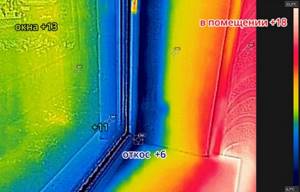
How to prepare for measurements
When is the best time to measure? As in the case of using a thermal imager, it is best to determine heat loss with a pyrometer at the maximum difference between street and room temperatures. However, GOSTs recommend that thermal audits be carried out during the autumn-spring heating period. The temperature difference must be at least 10 degrees.
Should I measure from the outside or from the inside? The survey will be most informative if you measure the building envelope on both sides. In practice, if you do not own a one-story cottage or an apartment on the ground floor, then it will be extremely difficult to maintain the same distance to all shooting areas from the street side. In addition, various hanging structures, for example, siding or block house cladding, can become an insurmountable obstacle to access to the walls from the outside.
Weather. You can start working with the pyrometer from the street side in the absence of precipitation, as well as smoke and fog. For the examination, you should definitely choose a time with minimal wind force.
Selecting the time of day. It is advisable to perform the search for heat loss with a pyrometer in the morning, when the surfaces being examined are not exposed to direct sunlight, which can heat the materials and distort information about the actual surface temperature. Evening is not the best option, since the walls can accumulate some amount of heat, although by the time of the examination they are no longer irradiated by the sun.
Stabilization of temperature in rooms. If this is a private house in which people stay from time to time, then the object must be heated for at least 3 days before measurements so that all elements of the building warm up. In any case, it is recommended to keep windows and doors at the facility closed for 12 hours.
Unobstructed access to enclosing structures. When taking measurements from the street, ice and snow must be removed from surfaces. When working indoors, you will have to remove paintings and carpets from external walls, and move furniture away. The pyrometer will not be able to “finish off” the wall if there are peeling wallpaper or any dirt in the path of its beam - it works exclusively on surfaces, under “line of sight” conditions. Also, experienced specialists strongly recommend dismantling the skirting boards on the outer wall and partially on the walls adjacent to it. If the task is to determine heat loss in a private house, then you will need access to the attic and basement.
